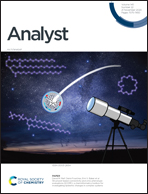Size-controlled synthesis of metal–organic frameworks and their performance as fluorescence sensors†
Abstract
Metal–Organic Frameworks (MOFs) are of bright promise as new fluorescence sensors because of their accurate framework structure and unique fluorescence properties. Many MOFs have been reported as fluorescence sensors, including bulk-MOF-crystals and nano-MOF-powder. Obviously, the sensing performance of these MOF sensors should be diverse due to their different sizes. However, bulk-MOF-crystals and nano-MOF-powder have completely different dispersibility in solvents, and the effects of this difference on the analytical performance like precision and sensitivity are significant but have not been discussed systematically. To investigate such effects, rodlike bulk-MOFs and nano-MOFs with the same structure but different sizes are required. In this work, we obtained MOFs with a crystal width ranging from 9.7 μm to 170 nm by controlled synthesis, and then proved that they have the same structure by PXRD, SEM, TGA and FTIR analysis. After that, taking folic acid as the target molecule, fluorescent sensing experiments were carried out to compare the sensing performance between bulk-MOFs and nano-MOFs. From the results, we found that nano-MOFs have obviously better dispersity, a lower precipitation speed, a smaller standard deviation, ten times higher fluorescence intensities and a much lower LOD than bulk-MOFs. Finally, we draw a conclusion that nano-MOFs are more in line with the requirements of analytical performance as fluorescence sensors, and the size of MOFs as fluorescence sensors should be as small as possible.



 Please wait while we load your content...
Please wait while we load your content...